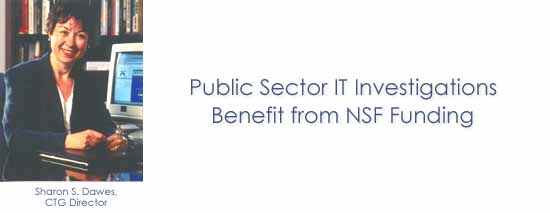
By Stephanie Simon, Center for Technology in Government
Making information technology work for government — this is what the Center for Technology in Government (CTG) does every day.
As a result:
- CTG helped the state Department of Motor Vehicles cut the vehicle title issuance process from 100 days to 30 — at a savings of $3 million.
- The center has shown the Governor�s Office of Regulatory Reform how voice-response technology can help small business entrepreneurs 24 hours a day, seven days a week.
- In the process of completing its projects, CTG has forged strong partnerships with 50 corporations. From 1993-98, private in-kind resources totaled $3.5 million.
- The center has recruited UAlbany faculty and students from many disciplines, including computer science, public administration and information science to bring their expertise to CTG projects.
In short, the work of CTG takes intensive research, analysis, and discovery to create innovative solutions to government information problems.
Thanks to the National Science Foundation�s appreciation for the power of multiple perspectives, the center has been able to conduct innovative work that benefits government and its citizens.
�The National Science Foundation�s willingness to fund multidisciplinary investigations is vital to the work we do at CTG,� said Director Sharon S. Dawes. �Our interest is in understanding the intricacies of technology development and use in complex organizations. No single kind of research can do this. It requires studying the many facets of government through a variety of lenses.�
Since 1997, the NSF has awarded CTG $1.4 million for four multidisciplinary projects aimed at helping government make better use of information and technology.
First, the Partnership for Advanced Computational Infrastructure (PACI) integrates various IT and computer science disciplines to help the U.S. stay on the leading edge of technology. As part of the Education, Outreach, and Training Team, CTG has been helping develop innovative applications of technologies designed to solve the practical problems of federal, state, and local governments. The center is the lead government partner in this NSF effort to build a national technology infrastructure for the 21st century.
�CTG�s work in the PACI program is helping to build more pragmatic technology tools that will benefit government, as well as business, industry, research, and education,� Dawes said. �These innovative tools will be used by government agencies and policy makers to solve the pressing societal problems, like environmental quality and economic forecasting, that demand intensive data analysis.�
In the second project, the center has been tapped by NSF to help define a new national research program on digital government. As part of this project, CTG conducted a multidisciplinary workshop in the fall of 1998. Participants devised recommendations that would help government create programs, like the Internal Revenue Service�s e-file and Telefile programs, that use technology to enhance customer service and program delivery. Those recommendations were detailed in a national report, Some Assembly Required: Building a Digital Government for the 21st Century, produced by CTG.
CTG�s third and most intensive project, which was awarded a three-year NSF grant in September 1999, involves investigation into the complex world of public sector knowledge networks. CTG is studying seven initiatives led by New York state and local agencies that depend on sharing knowledge and information across multiple organizations.
The fourth, and most recent, award is a Digital Government planning grant that will support UAlbany�s participation in a multi-national investigation into new models of collaboration for delivering services to citizens and businesses. CEFRIO, a Quebec research center devoted to understanding the use of information and communication technologies in public and private organizations, is a key partner. CTG will be working with CEFRIO researchers as well as faculty at the University of Quebec at Montreal and researchers from several selected U.S. institutions.
�It is only through intensive work with partners from all levels of the government, corporate, and academic sectors that we can unlock the puzzle of effective and innovative program management and service delivery in the public sector,� Dawes said. �The strong and continued support of NSF gives us the key.�
Back 